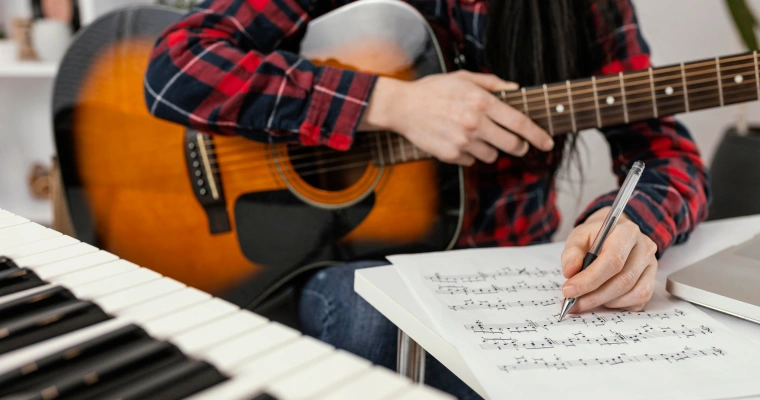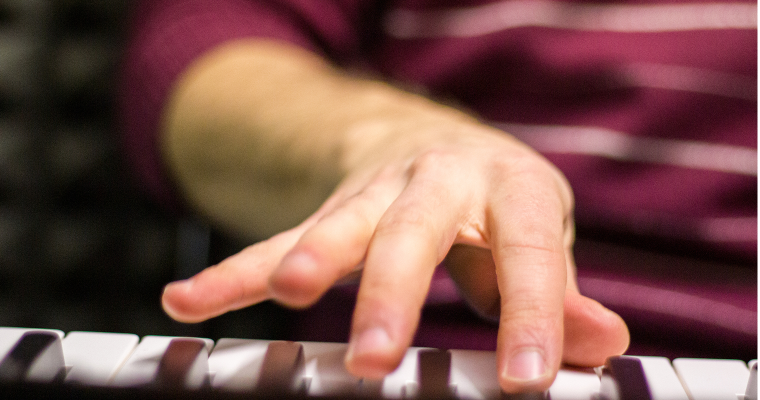Introduction: The Importance of Finger Strength and Dexterity for Pianists
“Wow! How can they play a piano like that? Is it for real? How are they able to do that?” Have you been this amazed after seeing someone playing a piano? Well, we guess most of you had. Also, somewhere or the other, you also think about their fast fingers movement, how well they control their keys, and yeah, the grace with which they play. But did you ever think of what helped them to reach that level of proficiency? Let us tell you that behind every expressive performance lies strong technique, especially finger strength and dexterity. Yes, these are the foundations that allow pianists to control the speed, dynamics, and expression of the music.
Less finger strength? Your hands will get tired in no time (even if you go to the gym). Lacking dexterity? Fast passages become sloppy. This is why you need mastery in finger strength and dexterity. And, it applies to both people looking to start or refine their advanced skills.
If you are aiming to master piano skills in Bangalore, we will help you find the right piano class.
What to Expect from a Piano Technique Class
Did you see that we wrote piano ‘technique’ class and not just piano class? Ohh, now you saw! Why did we do that? Because a piano technique class is quite different from a typical piano lesson. These specialized classes are designed to develop the physical skills necessary for playing the piano with efficiency, while expressing, and without strain. So, if you are planning to enroll in one of the piano technique classes, we’ll tell you what you can expect there.
1. Emphasis on Hand Position and Posture
Take a guess— what would instructors focus on at the beginning of a piano technique class? Not able to? Don’t worry, we are here! They emphasize on the basics— how you sit, where your hands are placed, how your fingers curve, etc. What has good posture to do with piano, you may ask. “A lot”, we would say. It is super important for avoiding injury and building control.
2. Targeted Finger Exercises
Expect a wide range of finger drills designed to build independence and strength. What can those be?
- Five-finger scale patterns
- Finger lifting and tapping exercises
- Trills and repeated-note drills
- Slow, controlled movements to improve accuracy
- Finger strength exercises for piano like Hanon and Czerny etudes
These drills are often repeated with different rhythms, articulations, and dynamics to enhance flexibility and speed.
3. Use of Technique Books and Exercises
Instructors often follow structured materials such as Hanon’s The Virtuoso Pianist, Czerny’s technical studies, or even modern finger fitness books. These help reinforce consistent practice habits and provide a clear progression path. Many piano classes for finger dexterity Bangalore offers use these resources to train students at all levels.
4. Hands-Separately and Hands-Together Practice
Teachers will often have students practice difficult sections hands separately before combining them. This improves coordination so that each hand can move independently— a key part of piano dexterity.
You’ll also work on contrary motion scales, broken chords, and other technical patterns that challenge the brain and fingers.
5. Strength and Endurance Building
To improve piano finger technique Bangalore style, classes include exercises that develop both short bursts of finger energy and sustained finger control. This might involve holding one note while playing others or playing through longer technical passages that require endurance.
Key Techniques to Improve Finger Dexterity
In simple terms, finger dexterity means your fingers can move independently, quickly, and smoothly. Let’s run you through some techniques that are used in piano lessons for finger strength and dexterity.
- Five-finger scales – playing a five-note scale, in a repeated manner, using each hand to isolate and strengthen each finger.
- Hanon exercises – a famous set of finger drills that improve both strength and coordination.
- Contrary motion scales – practicing scales in opposite directions to increase coordination between both hands.
- Playing with dynamics – varying loudness and softness during technical drills to improve control.
- Isolated finger lifts – lifting and lowering individual fingers while keeping others still.
How Piano Classes in Bangalore Can Help
Bangalore has become a hub for quality music education. Whether you’re into keyboard lessons for beginners, Hindustani classical music, or guitar classes for beginners, there’s something for everyone. But for piano technique, the city offers high-standard training.
In the dedicated piano classes for finger dexterity Bangalore has, students are taught how to build strength. There, teachers offer:
- Personalized finger strength drills
- Progressive lesson plans
- Real-time feedback and corrections
- Techniques to avoid fatigue and injury
Exercises for Building Finger Strength and Dexterity
To improve piano finger technique Bangalore style, consistent practice is necessary. Want some of the most effective finger strength exercises for piano? Let’s go!
- Hanon Exercise No. 1 – Focus on even tone and relaxed wrists.
- Trill Exercises – Rapid alternation between two fingers, great for finger independence.
- Arpeggios and broken chords – Help strengthen both weak and dominant fingers.
- Staccato Practice – Short, detached notes build control and precision.
- Finger Push Ups – Lifting each finger off the key slowly and pressing it down with force while the other fingers remain steady.
A qualified teacher in one of the advanced piano technique Bangalore classes will not only introduce these exercises but also help you to carry them out correctly.
Benefits of Structured Piano Lessons
Now, let’s hop on to one of the most important parts of this article. What do you think structured piano lessons offer? Learning to play songs? Well, well, they offer far more than just that. What they provide is a guided pathway to develop proper technique. A technique that helps to improve finger strength and dexterity. So, if you are serious about building a strong foundation in piano, you know where your mind should be. Why? Okay, so you are not yet convinced. No worries, we’ll try harder and give you more detailed reasons.
1. Expert Supervision and Technique Correction
Do you know why Guru Dronacharya was one of the greatest teachers? Because he always observed his students and corrected their techniques in real-time. You’ll have the same advantage in structured piano lessons. Small errors— like collapsing fingers, stiff wrists, or incorrect hand posture— can lead to long-term bad habits or even injury. When you have an expert with you, they will address these concerns early on.
2. Step-by-Step Progression
We are talking of structured classes, and how did you think we would neglect the word ‘structure’? As the name suggests, structured classes follow a planned syllabus. A syllabus that brings you new skills over time. Yeah, you start with basics— hand position, five-finger exercises, and all. After that? You move on to finger strength exercises and advanced patterns. This progression helps you gain all the information with more effectiveness. Also, your technique builds up in a natural manner.
3. Personalized Feedback
Every student is different. Structured lessons allow teachers to tailor exercises and guidance to your unique needs. Whether you have weaker ring fingers or struggle with speed, the teacher can provide specific drills to help you improve. This is more useful in piano classes for finger dexterity, where a customized approach helps students progress faster.
4. Motivation and Accountability
When learning alone, it’s easy to get distracted or unmotivated. Regular lessons keep you committed. Knowing that your teacher will hear your progress every week encourages consistent practice. This accountability can be the key difference between giving up and mastering piano skills.
5. Access to Proven Methods
Structured piano classes often include established technique-building materials such as Hanon, Czerny, and other finger independence drills. These resources are used by professionals and have stood the test of time. Learning them under the guidance of a teacher will help you understand how to use them to improve piano finger technique.
Choosing the Right Piano Classes in Bangalore
The city has a variety of music institutions and private tutors. But how do you pick the right one for finger technique?
Here are a few tips:
- Look for specialized classes in finger technique or technical development.
- Check the instructor’s background – do they have classical training or performance experience?
- Ask about the curriculum – does it include Hanon, scales, and dexterity drills?
- Evaluate the learning environment – is it supportive, clean, and well-equipped?
Consider other offerings – many schools also teach Bharatanatyam dance classes, or guitar classes for beginners, which can be an indicator of the school’s all-around quality. You may also be interested in the Carnatic music classes Bangalore offers.
What to Expect from a Piano Technique Class (Revisited)
To really get a sense of what your lessons might look like, let’s revisit this in more detail. In a typical 60-minute piano technique class, you might go through:
- 10 mins warm-up (scales or five-finger exercises)
- 15 mins technique drills (Hanon, arpeggios)
- 15 mins repertoire practice (focusing on applying technique)
- 10 mins finger independence training (trills, lifting, drills)
- 10 mins feedback and homework
These classes help build a solid base whether you’re taking keyboard lessons for beginners or preparing for advanced performance.
Why Finger Strength Matters in Piano Playing
Finger strength isn’t just about playing fast. It gives you:
- Control over dynamics (soft or loud notes)
- Endurance to play longer pieces
- Accuracy in fast passages
- Confidence during live performance
- Expression, because every finger movement contributes to the emotion in your music
Strong fingers make a strong pianist. With consistent effort and good training, finger strength and dexterity can transform your playing style and sound.
Conclusion
Mastering finger strength and dexterity is not just for advanced pianists. It’s crucial for anyone who wants to play with ease, confidence, and beauty. The good news? You don’t have to do it alone.
Piano classes in Bangalore offer expert guidance to help you enhance control, speed, and precision in your playing. Whether you’re a beginner or someone looking to refine your skills, the city has resources that can help you grow.
So, if you’re ready to improve your technique, start with structured piano lessons for finger strength and join the many students choosing to improve piano finger technique Bangalore style.
FAQs
1. Why is finger strength important for piano playing?
Finger strength allows you to play with better control, endurance, and dynamic range, and hence makes your performance smoother and more expressive.
2. How can piano classes in Bangalore help improve finger dexterity?
These classes focus on proven exercises, guided practice, and expert feedback to improve finger independence, speed, and accuracy.
3. Are these classes suitable for beginners?
Yes, many schools in Bangalore offer keyboard lessons for beginners with a strong emphasis on technique and building foundational finger strength.
4. How long will it take to improve finger strength and dexterity?
With regular practice and guided training, you can see noticeable improvements in as little as 4–6 weeks.
5. Do I need any prior piano experience to start improving finger strength?
No prior experience is needed. Basic technique classes are designed to help even complete beginners build strength and coordination from day one.




